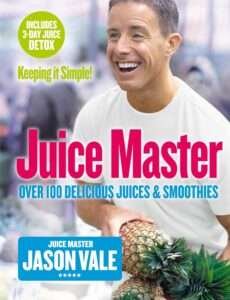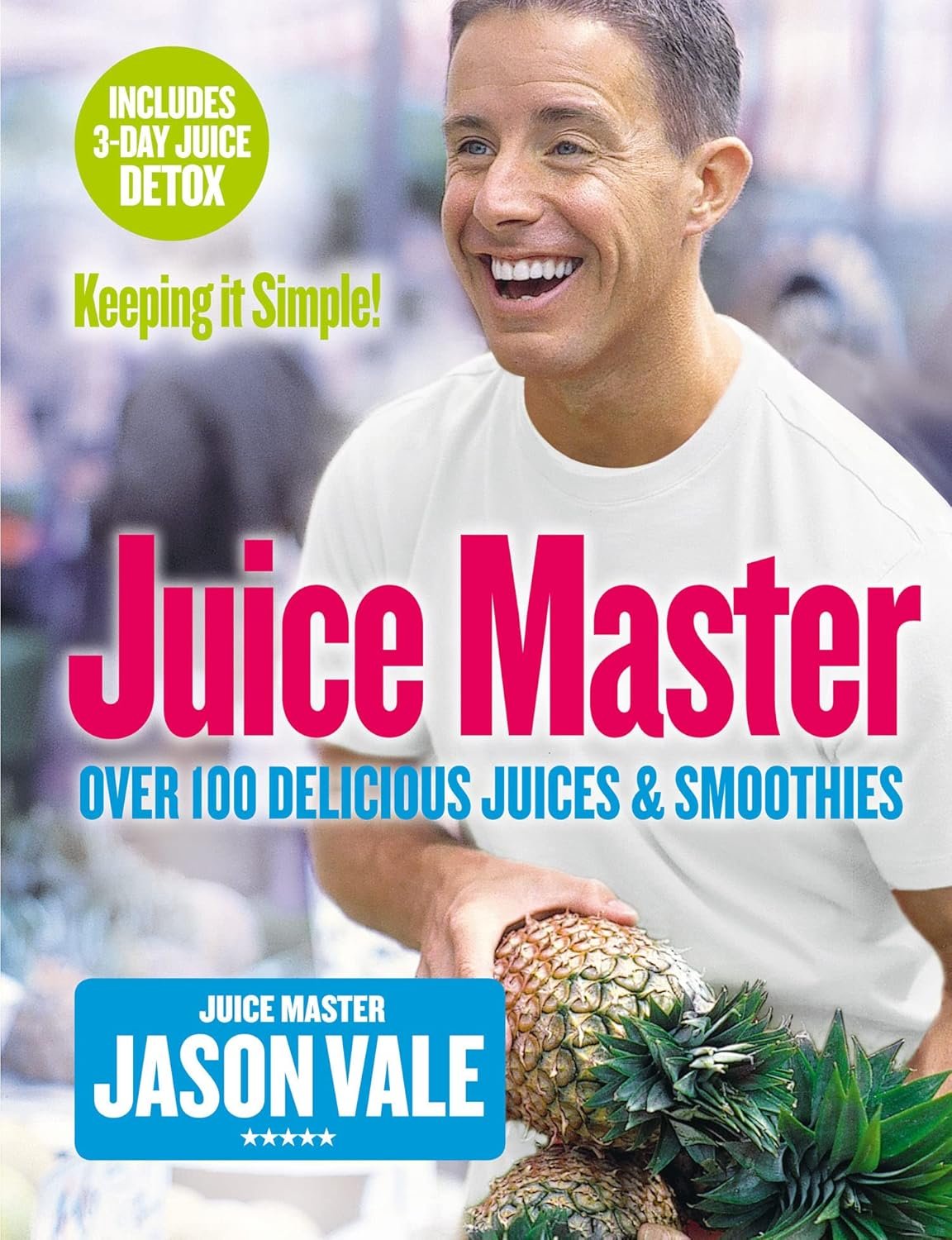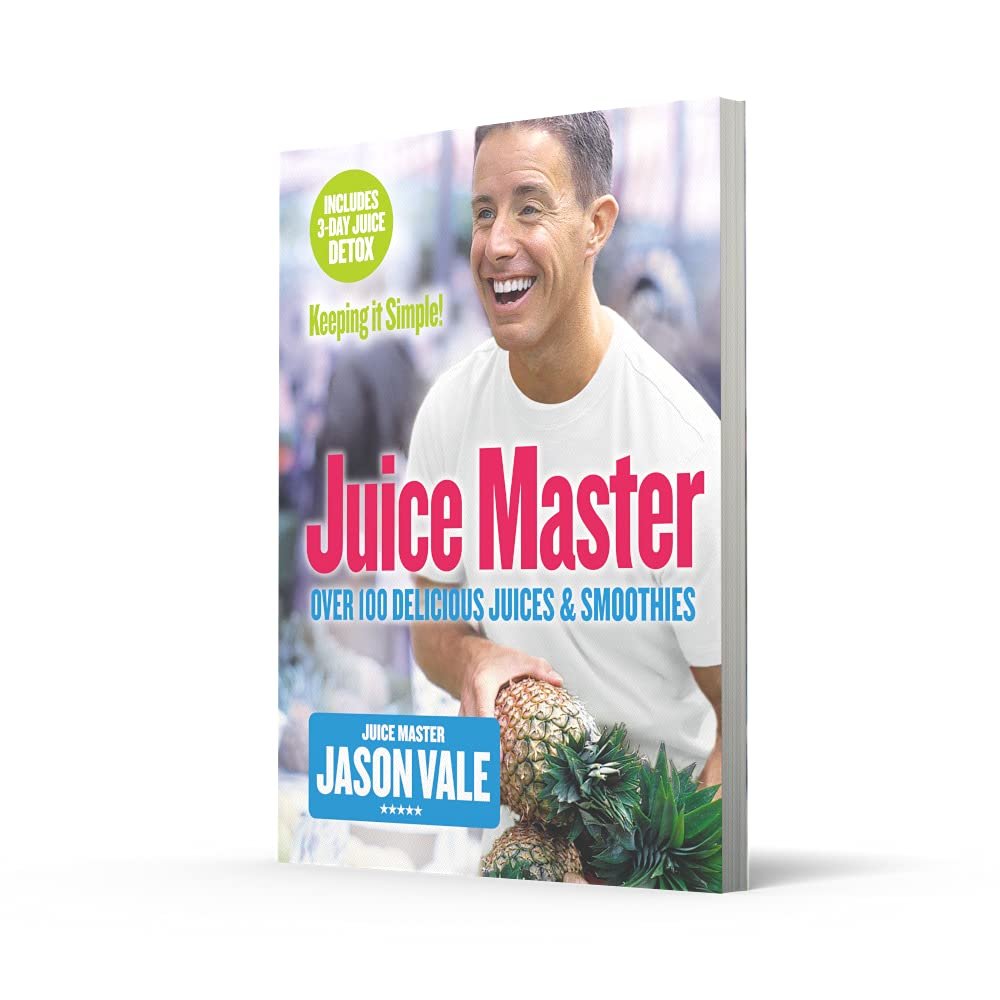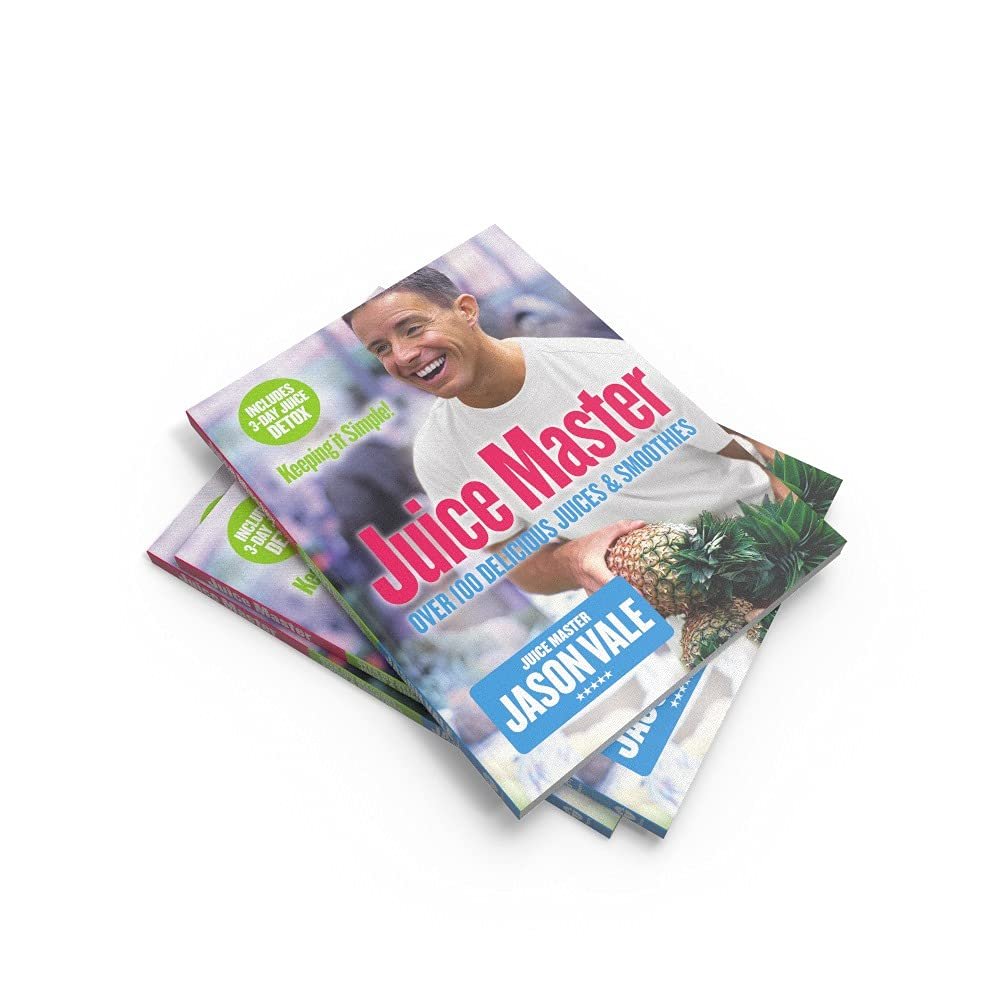This Juice Master Keeping It Simple Review explores Jason Vale’s well-known book designed to simplify juicing for everyday life. We break down the key takeaways, strengths, and whether this guide is the right starting point for beginners who want to juice with confidence and consistency.
Quick take
You’ll find that Juice Master Keeping It Simple: Over 100 Delicious Juices and Smoothies Paperback – 2 April 2007 aims to take the guesswork out of making fresh juices and smoothies. The book presents recipes that are approachable, simple to follow, and designed to fit easily into your daily routine.
About the product
You should know this is a recipe collection focused on juices and smoothies, compiled under the Juice Master brand. The book emphasizes simplicity and accessibility, which is handy whether you’re starting a juicing habit or just want quick ideas for healthy drinks.
What it promises
It promises a collection of more than 100 recipes that are easy to prepare and geared toward everyday use. You’ll find recipes that promise to be both tasty and health-conscious without requiring a degree in nutrition to follow.
Who it’s for
This book is tailored to people who want uncomplicated recipes and practical guidance rather than dense nutrition theory. If you prefer clear instructions, minimal fuss, and a friendly style, you’ll likely enjoy what the book provides.
Contents and structure
The book’s layout is organized so you can flip to a recipe and get started quickly. You’ll find recipe titles, ingredient lists, and preparation steps presented in a way that minimizes confusion and speeds up your time in the kitchen.
Recipe breakdown
Recipes are grouped by type and function, with juices and smoothies separated for quicker navigation. Each recipe lists ingredients and the steps required, so you can see at a glance whether you have what you need to make it.
Organization and layout
Chapters are arranged to guide you from beginner basics toward a broader variety of options, with practical notes sprinkled throughout. The layout favors readability, and you won’t have to hunt through dense paragraphs to find a measurement or step.
Visuals and photography
Photography and visuals are included to give you a preview of finished drinks, helping you decide which recipes to try first. The images are generally clear and appetizing, which makes it easier to match expectations to results.
Usability
You’ll appreciate how focused the book is on making the process simple and quick, whether you’re squeezing citrus or putting fruit and greens in a blender. The recipes are written in plain language, which reduces the intimidation factor for newcomers.
Difficulty level and skill required
Most recipes are beginner-friendly and require no advanced techniques beyond common kitchen tasks like chopping and measuring. You won’t need specialized training—only basic knife skills and familiarity with your juicer or blender.
Equipment and ingredients
The majority of recipes assume you have a basic juicer or blender and a few staple ingredients like apples, carrots, leafy greens, berries, and citrus. When a recipe calls for something less common, the book typically suggests substitutes so you can improvise with what you have.
Time and prep
Preparation times are generally short, and many recipes are ready in minutes, which makes the book practical for busy mornings or quick afternoon refreshments. You’ll also find tips for preparing ingredients in batches to save time during the week.
Taste and variety
You can expect a broad range of flavors, from bright and citrusy to creamy and subtly sweet, allowing you to match drinks to your mood or meal. The variety helps prevent recipe fatigue, so you’re less likely to reach for the same drink every day.
Flavor profiles
Recipes balance sweetness and acidity using fruit and vegetable pairings that work well together. The book often suggests complementary ingredients that enhance flavor without relying on added sugars or artificial flavorings.
Seasonal suitability
Many recipes use seasonal produce, which helps you get the best flavor and value throughout the year. You’ll find guidance on choosing seasonal swaps so you can adjust recipes based on what’s fresh and available.
Health and nutrition
The collection leans toward healthful options with an emphasis on fresh produce, vitamins, and hydration. You’ll get plenty of recipes that prioritize whole-food ingredients and minimal processing.
Nutritional focus
The recipes highlight natural nutrients from fruits and vegetables, and you’ll see combinations designed to provide vitamins, minerals, and phytonutrients. While the book isn’t a deep nutrition textbook, it gives practical ideas for optimizing daily intake through drinks.
Allergies and dietary needs
The book is adaptable for common dietary restrictions, and you can usually modify recipes to be dairy-free, vegan, gluten-free, or nut-free. When necessary, the instructions include swap options or alternatives to accommodate preferences or allergies.
Practical performance
You’ll find this book performs well as a quick-reference guide. It’s especially useful on busy days when you want a nutritious drink without spending much time planning or prepping.
Batch preparation
The book offers tips for prepping ingredients in advance so you can blend or juice quickly during the week. You’ll benefit from suggestions on how to store prepped fruits and vegetables for freshness and quick use.
Serving suggestions
Recipes often include plating or serving ideas—like serving chilled, adding ice, or combining with other light snacks—that help you enjoy the drink as part of a meal. These small suggestions help elevate simple recipes into satisfying moments.
Pros and cons
You’ll want an honest look at what the book does well and where it falls short to decide if it matches your needs.
Strengths
One of the main strengths is clarity: recipes are easy to follow and ready to use. The focus on simplicity makes it accessible, and the variety of recipes keeps your menu interesting.
Weaknesses
The book is not a deep dive into nutrition science or therapeutic juicing protocols, so if you want extensive clinical detail, you might find it light. Additionally, some readers might wish for more creative or gourmet-style recipes, as the emphasis is on straightforward, everyday options.
How it compares to other juicing books
When compared with other juice and smoothie books you might own or consider, this title stands out for straightforwardness and ease of use. It doesn’t overwhelm with technical detail, so it’s a solid choice if you prefer practical instruction over theoretical depth.
Compared to advanced juicing guides
Advanced guides often include more technical details, cleansing plans, or medical claims; this book keeps things practical and approachable. If you’re seeking a strict detox regimen or medically supervised plans, this isn’t the primary resource for that.
Compared to online recipes and apps
Online recipes and apps can offer a huge variety, user reviews, and dynamic search, but they sometimes lack editorial consistency. You’ll find consistency in recipe style and quality in this book that can be comforting if you prefer a curated, reliable physical reference.
Presentation and readability
The book’s language is friendly and conversational, making it easy for you to read and follow. You’ll appreciate the succinct directions and helpful notes that reduce the chances of a recipe turning out differently than expected.
Tone and voice
The voice is supportive and simple, guiding you through each recipe without presuming advanced knowledge. This tone is welcoming and practical, which helps you feel confident trying new combinations.
Layout and navigation
Clear headings, categorized recipes, and an uncluttered layout make it straightforward to find what you’re looking for. You won’t spend much time flipping pages to find measurements or steps.
Ingredient accessibility
Most ingredients used in the book are common and easy to find at supermarkets or farmers’ markets. For the occasional specialty ingredient, the book suggests alternatives so you can still make a similar drink.
Common pantry items
You’ll see many recipes featuring staples like bananas, apples, carrots, spinach, and citrus fruits, which keeps shopping lists short and affordable. These ingredients also travel well across seasons and regions.
Handling specialty produce
When a recipe calls for a less common item, the book typically provides swap suggestions so you can adapt without losing too much flavor or texture. That helps you stay flexible and creative without breaking the bank.
Tools and equipment recommendations
While the book assumes a basic juicer or blender, it also offers guidance on which features matter most when choosing equipment. You’ll learn practical tips for getting the best yield or texture with the tools you already own.
Juicers vs. blenders
The book clarifies when to use a juicer versus a blender, emphasizing convenience and the type of result you want—clear juice or thick smoothie. It helps you match the recipe to your appliance so you achieve the intended consistency.
Recommended extras
You’ll find small suggestions like using a mesh strainer for smoother juices, reusable bottles for storage, and good-quality knives for prep that make the process easier. These are simple, cost-effective tips that improve outcomes without requiring a big investment.

Time-saving strategies
The book gives several practical strategies to reduce prep time and make routines sustainable. If you’re busy, these tips help you maintain healthy habits without adding stress.
Prep-ahead methods
You’ll get guidance on chopping, portioning, and freezing ingredients so you can assemble drinks quickly during the week. Preparation techniques also help you minimize waste and maximize flavor retention.
Quick swaps and shortcuts
The recipes often include shortcuts like using pre-washed salad greens or canned coconut milk for convenience. You’ll be able to balance speed and quality with the suggested swaps.
Storage and shelf life
Understanding how long juices and smoothies last is key to using the book effectively, and the book offers practical guidance on freshness. You’ll learn best practices for storing drinks to keep flavor and nutrients stable.
Freshness tips
The book recommends storing in airtight containers and consuming juices soon after making them for maximum nutrient retention. It also suggests chill times and ways to keep drinks tasting fresh if you need to prepare them ahead.
Freezing and reheating
While freezing is possible for some smoothies, the book warns that texture may change; tips are provided for thawing and re-mixing to regain a pleasant consistency. You’ll find sensible guidelines so you can plan for times when you want to prepare ahead but still enjoy quality.
Adapting recipes for your needs
You’ll appreciate how easily recipes can be modified for taste, texture, and dietary needs. The book encourages substitutions and gives ideas to personalize drinks so they better fit your preferences or restrictions.
Flavor adjustments
If a recipe is too sweet or too tart for you, the book suggests small adjustments—like adding a splash of citrus, a bit more water, or a handful of greens—to fine-tune flavor. These tweaks help you make each recipe into something you truly enjoy.
Nutritional substitutions
You’ll find advice on swapping ingredients to change calorie or macronutrient profiles, such as replacing fruit with avocado for creaminess with less sugar. These swaps let you lean the drink toward energy, protein, or lower sugar depending on your goals.
Cost and value
Buying a recipe book is partly about convenience and partly about value; this book offers both by collecting tested recipes in one accessible place. If you value a physical reference and consistent formatting, the purchase can pay off in saved time and fewer failed attempts.
Ingredient cost considerations
Because many recipes use common produce, you won’t typically incur high grocery bills, and seasonal choices help lower cost further. You’ll find that a small initial investment in quality produce and a good blender or juicer yields many enjoyable drinks.
Long-term value
Once you’ve built a repertoire of favorite recipes from the book, you’ll use it repeatedly, which increases its value over time. The simplicity and variety help make it a durable kitchen companion rather than a one-time read.
Who should buy it
If you want to establish a simple juicing or smoothie habit without getting bogged down in technical details, this book fits the bill well. You’ll find it especially helpful if you like having a physical collection of recipes you can rely on without needing an internet connection.
Best fit audience
This book is ideal for beginners, busy people, and those seeking straightforward, practical recipes for daily use. If you want reliable, easy recipes rather than experimental or scientific treatments, you’ll appreciate its focus on simplicity.
Who might look elsewhere
If you need clinical-level nutrition plans, strict detox protocols, or ultra-gourmet recipes with complex ingredients, you might want to supplement this book with more specialized resources. The book’s strength is in practicality, not exhaustive clinical guidance.
Final verdict
Juice Master Keeping It Simple: Over 100 Delicious Juices and Smoothies Paperback – 2 April 2007 is a practical, friendly guide that makes it easy to add fresh juices and smoothies to your life. You’ll find clear instructions, accessible ingredients, and useful tips that help you succeed without stress.
Recommendation summary
If you want approachable recipes, minimal fuss, and a sensible range of flavor profiles, this book is a solid choice for your kitchen library. It gives you the tools and inspiration to make healthier drink choices on a regular basis without feeling overwhelmed.
Purchase considerations
When deciding whether to buy, consider how often you’ll use the book and whether you prefer a printed, curated set of recipes over searching online. If you value consistency and clarity, you’ll likely find the purchase worthwhile.
Comparison table for quick reference
Below is a table that breaks down key aspects of the book in a way that helps you compare and decide quickly. You can use it to match the book’s features to your priorities.
| Feature | What you get | Why it matters to you |
|---|---|---|
| Recipe count | Over 100 recipes | Plenty of variety to keep you interested |
| Skill level | Beginner to intermediate | No advanced skills required |
| Equipment | Basic juicer or blender | No expensive tools required |
| Ingredient accessibility | Mostly common produce | Easy to shop and budget-friendly |
| Nutrition focus | Practical, whole-food based | Promotes healthy habits without heavy theory |
| Prep time | Generally minutes to ~15 minutes | Fits into busy schedules |
| Visuals | Clear photos for many recipes | Helps set expectations for results |
| Adaptability | Substitutions suggested | Useful for dietary needs and preferences |
| Specialization | Not clinical or detox-specific | Best for everyday use and general health |
| Value | Good long-term usability | Reusable reference for routine use |
Practical starter plan you can follow
You’ll find it helpful to have a simple plan when you first start using the book so that recipes become part of your routine. Below is an approachable week plan that makes use of the book’s practical design.
7-day starter rhythm
- Day 1: Choose a morning fruit smoothie for energy. Keep it simple and familiar so you feel successful.
- Day 2: Try a green juice mid-afternoon for a vitamin boost. Note how you feel and adjust ingredients to taste.
- Day 3: Make a creamy smoothie with a plant-based protein for a post-workout refuel. Track fullness and energy.
- Day 4: Prep fruit and greens in portions for the rest of the week to speed up future blends. Keep each portion in an airtight bag.
- Day 5: Try a citrus-based juice with a hint of ginger for a digestion-friendly option. Notice the refreshing effect.
- Day 6: Swap a typical sugary snack for a vegetable-forward smoothie to compare satisfaction and energy levels.
- Day 7: Review favorites and make a grocery list of staple items to restock for the following week.
Troubleshooting common issues
You’ll likely face a few simple hurdles that are easy to fix once you know how. The book’s practical tone means it anticipates common problems and suggests straightforward solutions.
Separation or watery texture
If juices separate or smoothies become watery, try adding a thicker ingredient like banana, avocado, or a small amount of nut butter. You can also reduce water content and blend longer for a smoother texture.
Flavor too strong or too weak
Adjust sweetness with fruit or a splash of citrus if a recipe tastes flat, or add more greens and water if it’s too sweet. Small adjustments help you reach a balanced flavor that suits your palate.
Waste reduction
If produce goes bad before you can use it, consider freezing portions or making larger batches to preserve freshness. The book’s prep-ahead tips are useful for limiting waste and saving money.
Closing thought
You’re getting a friendly, practical guide with Juice Master Keeping It Simple: Over 100 Delicious Juices and Smoothies Paperback – 2 April 2007 that prioritizes simplicity, taste, and daily usability. If your goal is to make fresh drinks a regular, enjoyable part of your life without overcomplication, this book gives you a reliable blueprint to do just that.
Disclosure: As an Amazon Associate, I earn from qualifying purchases.






